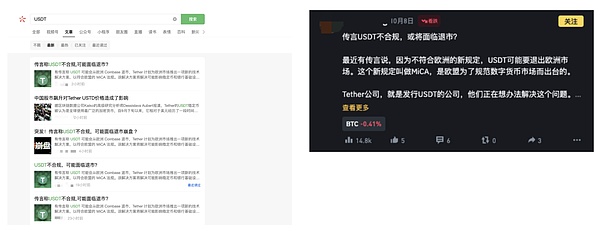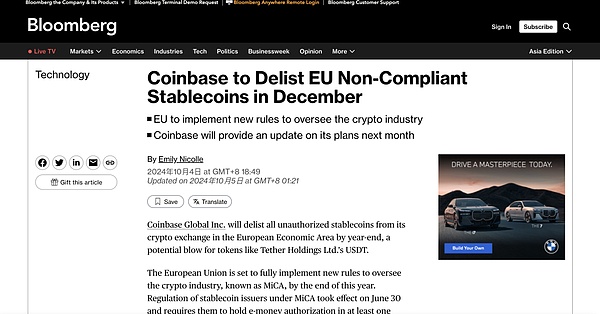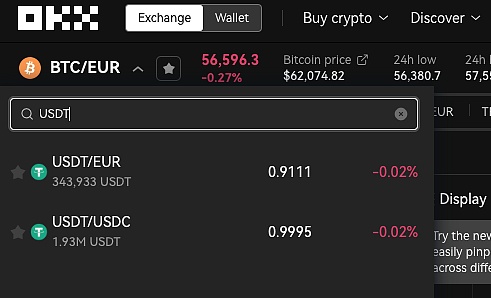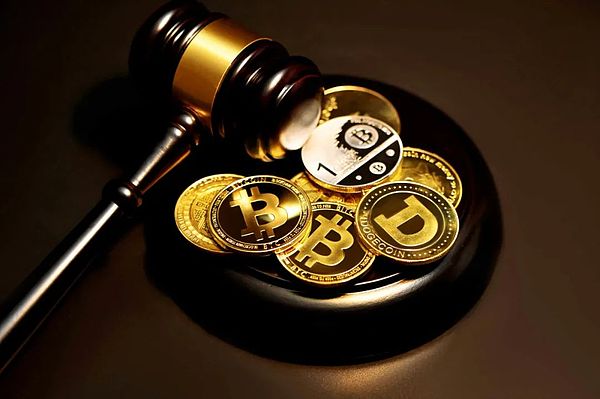Author: Lawyer Liu Honglin
In the past two days, I wonder if all the players in the currency circle have paid attention to a piece of news. It is said that Tether USDT may face delisting due to non-compliance. As of the time of writing, a search for "USDT" on WeChat will also pop up multiple related information. Other vertical media platforms, such as the communication square of a well-known virtual currency exchange, also have discussions on related news.

There is an old saying that "bad news spreads a thousand miles away." Especially in the currency circle driven by fear (FOMO), USDT, as the most widely used entry-level virtual asset, will inevitably cause a "big earthquake" in the currency circle once it "collapses." You know, everyone in the currency circle has hundreds or thousands of USDT in their hands!
During the USDC depegging storm in March 2023, panic-stricken people in the crypto community sold a large number of USDC, some well-known crypto institutions and market makers (IOSG, Jump, etc.) took emergency risk hedging measures, and the leading virtual currency exchanges also urgently suspended the USDC exchange channels... Subsequently, the pressure on the chain skyrocketed. Since the DeFi ecosystem is heavily dependent on USDC, this depegging caused a serious tilt in the liquidity pool and triggered the depegging of stablecoins such as DAI and FRAX, as well as subsequent on-chain liquidations.
But will USDT really face delisting due to non-compliance? Lawyer Mankiw said: Don't take things out of context!
The truth about USDT’s “delisting”
Back to October 4th, when we were still immersed in the joy of the National Day holiday, Bloomberg released a news about “Coinbase will delist stablecoins that do not comply with EU regulations”, thus kicking off the farce of “USDT will be delisted”.

*Source: Bloomberg News Screenshot
The news pointed out that with the full entry into force of the EU MiCA Act in December, Coinbase will restrict the provision of services related to stablecoins that do not meet MiCA requirements to EEA users after December 30, 2024 in order to comply with regulations. In simple terms, after December 30, Coinbase will remove all stablecoins that do not meet MiCA requirements, but only in the EU.
We also know that so far, due to various factors, Tether (USDT issuer) has not obtained the EU stablecoin issuance license, which means that if Tether fails to meet the MiCA requirements and fails to obtain the stablecoin issuer's license in the remaining 3 months, Coinbase will remove USDT related services in the EU.
However, as the news spread, it became that Coinbase will remove USDT at the end of the year.
So, if Tether really fails to obtain the MiCA stablecoin issuer's license by the end of the year, and Coinbase removes USDT, what impact will it have on the currency circle?
There are problems, but only in the EU
At present, in addition to Coinbase, other well-known virtual currency exchanges, such as Binance and OKX, have also announced the removal of unlicensed stablecoins in order to comply with the EU MiCA requirements. In other words, starting in 2025, EU currency players will not be able to buy and sell this type of stablecoin on compliant virtual currency trading platforms. However, except for EU users, currency players in other countries and regions are not affected, so users who trade on compliant platforms do not need to worry too much.
However, some people are still worried that if EU users cannot use USDT and there is a selling spree, will it cause USDT selling pressure, and then de-anchoring and subsequent impacts? Lawyer Mankiw believes that there will be some impact, but the problem is not very big. There are three reasons:
First, for EU users, platforms that can trade virtual currencies are not limited to these compliant exchanges. More non-compliant but still "strong in the front line" centralized exchanges (CEX), and even decentralized exchanges (DEX) are still their potential choices.
Second, according to TokenInsight, as early as March, OKX announced that it would stop providing EU users with USDT stablecoin-denominated cryptocurrency trading pairs. At present, users with EU IPs can only use USDT/EUR and USDT/USDC trading pairs when entering OKX. But obviously, the impact is not significant.

*Source: Screenshot of the page where EU IP enters the OKX platform
Third, as early as before and after the MiCA stablecoin issuer clause came into effect, the market had already rumored that USDC had obtained a license and would replace USDT, so EU users had been given more expectations and transition period. In addition, from the perspective of market liquidity, USDT users are more concentrated in Asia rather than Europe.
Of course, according to the information disclosed by Tether, they are actively building new technologies and models to meet the regulatory challenges brought by MiCA. Therefore, in general, apart from the panic caused by rumors, the delisting itself has little impact on the market. However, as many countries and regions around the world begin to seek regulatory legislation for stablecoins, such as Hong Kong's launch of the establishment of stablecoin issuer clauses and issuer regulatory sandboxes, stablecoin issuers represented by USDT will inevitably face regulatory challenges in more regions.
In this context, currency circle players need to pay attention to understanding the local regulatory policies in advance and adjust their investment strategies in a timely manner to avoid the impact of regulation.
Global Stablecoin Regulation
At present, in addition to the MiCA stablecoin issuer clauses that have come into effect, many countries and regions have already started regulatory legislation and law enforcement for stablecoins. Popular locations for Web3, such as:
1 United States
The United States, which is known for its harsh crypto enforcement, currently has no dedicated regulations for stablecoins, but the Treasury Department's Financial Crimes Enforcement Network (FinCEN) considers stablecoins to be convertible virtual currencies (CVCs), so existing financial regulations apply. Despite the lack of dedicated stablecoin legislation, Congress has introduced several bills aimed at establishing a clearer regulatory framework. Notable proposals include the Stablecoin Trust Act and the Stablecoin Act, which propose that stablecoin issuers should either become insured depository institutions or be licensed under federal or state law. These proposals reflect growing concerns about the regulatory environment for stablecoins, especially against the backdrop of the expanding use of stablecoins in the financial ecosystem.
In addition to FinCEN, other regulators, such as the Securities and Exchange Commission (SEC) and the Commodity Futures Trading Commission (CFTC), may also regulate stablecoins based on their structure or related products. The Federal Reserve and the Presidential Working Group on Financial Markets have also warned of the risks that stablecoins may pose, especially regarding financial stability and systemic risks. Ongoing discussions indicate that in order to reduce these risks, stablecoin issuers may face regulatory provisions similar to those of banks.
2 United Kingdom
There is currently a Digital Asset Framework Proposal, which is under the responsibility of the UK Financial Conduct Authority (FCA) and focuses on regulating stablecoins backed by fiat currencies, requiring stablecoin issuers and custody service providers to be authorized and must meet strict regulatory standards, including asset isolation, sound governance controls, and maintenance of detailed records. In addition to these requirements, the UK (FCA) also emphasized that stablecoin issuers need to maintain strong prudential protections to protect consumers and the broader financial system. The proposed rules also highlight the importance of ensuring that stablecoins can be redeemed at par (i.e., backed 1:1 with fiat currency). The FCA is actively working with other global regulators to coordinate standards and ensure a consistent approach to the regulation of stablecoins across jurisdictions.
3 Hong Kong, China
At the end of August, the Hong Kong Treasury and the HKMA issued a consultation summary on the regulatory regime for stablecoin issuers and launched the Stablecoin Issuer Sandbox Program, announcing the participation of three companies. Stablecoin issuers must obtain a license from the Hong Kong Monetary Authority and strictly comply with requirements such as reserve management and financial resources. However, the Sandbox Program has not yet been participated by native Web3 stablecoin issuers, and the stablecoin issued is the Hong Kong dollar stablecoin. Therefore, whether the future regulatory policy of Hong Kong stablecoin issuers will have an impact on stablecoins such as USDT and USDC is still unknown.
4 Singapore
The Monetary Authority of Singapore (MAS) released a consultation document feedback on the regulation of stablecoin issuers in 2023, confirming its intention to regulate stablecoin-related activities under the new Single Currency Stablecoin (SCS) Framework. The introduction of this framework aims to ensure the stability of stablecoins and their compatibility with Singapore's financial system. Similarly, the framework requires stablecoin issuers to obtain official licenses and comply with a series of strict regulations, including but not limited to reserve asset management, guaranteed redemption at par, and transparency disclosure. In addition, MAS will also impose prudential and solvency requirements on stablecoin issuers to ensure the integrity of the market and the protection of consumer interests. Although these measures increase the operational difficulty of issuers, they are seen as necessary steps to maintain the stability and integrity of financial markets.
5 Japan
To engage in stablecoin-related business in Japan, entities must obtain stablecoin-related licenses by registering as Electronic Payment Instrument Service Providers (EPISP). This requirement was introduced in the revised Payment Services Act (PSA) in June 2023. Japan's latest stablecoin regulatory regime has strict requirements for the issuance and management of stablecoins, such as stablecoin issuance must be pegged to a specific legal currency and promised to be redeemed at the same value as the issue price. Stablecoins such as USDT and USDC are considered electronic payment instruments in Japan and are regulated by the PSA. In addition, non-electronic currency stablecoins such as DAI, that is, crypto-asset stablecoins that are not directly linked to fiat currencies, are classified as crypto assets and may be regulated in accordance with the Financial Instruments and Exchange Act (FIEA).

As global stablecoin regulation continues to evolve, various policies have brought significant challenges to issuers. In the United States, the lack of specific legislation, coupled with strict supervision by multiple government agencies, has increased the compliance burden of stablecoin issuance and may limit the innovation and operational flexibility of stablecoin issuers. Similarly, the UK Financial Conduct Authority (FCA)'s strict requirements for authorization and consumer protection may bring additional costs and operational restrictions. Hong Kong's regulatory uncertainty over its current sandbox program adds complexity, especially for stablecoins that are not directly aligned with local currencies. Similar to the above jurisdictions, Singapore and Japan have been criticized for the restrictiveness of their stablecoin regulatory systems, which industry participants believe may inhibit innovation, limit competition in the crypto market, and may lead to increased centralization of the stablecoin market.
It is foreseeable that changes in global regulatory dynamics will inevitably affect the market share of various stablecoins, and thus affect the virtual assets of users. Therefore, when participating in virtual currency transactions, what can we do to cope with the market changes caused by regulation?
Things to note for cryptocurrency players
Previously, Mankiw interpreted the judicial interpretation of virtual currency money laundering issued by the two high courts of China, and it was also due to the unclear media reports that caused panic among cryptocurrency players. Therefore, in conjunction with this "big earthquake", lawyer Mankiw believes that the following key points need to be noted: 1. Understand regulatory policies. Fear often comes from the unknown. When we do not understand regulatory policies, we will naturally be carried away by exaggerated media reports and market sentiment. For example, this time, those who understand the specific content of MiCA and Coinbase naturally know that USDT is not a big problem. Therefore, when seeing media reports, it is better to trace the source first, understand the relevant regulatory policies first, and be a reasonable person. If you really can't figure it out, consulting a lawyer is also a very smart choice. Before, when the judicial interpretation of the two high courts on money laundering was just issued, a friend consulted in the Mankiw communication group and got the answer in seconds.
2 Adopting a compliant platform
Compliance participation is the biggest reliance for reducing losses. Virtual currency exchanges that have fully complied with local laws and international regulations can not only provide higher security and fund protection, but they are also at the forefront of supervision, can make timely adjustments in accordance with policy changes, and provide users with sufficient funds for redemption and exchange transition period. For example, the two USDT trading pairs currently provided by OKX for EU users can ensure that EU users can exchange their USDT into compliant stablecoins before 2025.
3 Diversified investment strategy
Don't put all your eggs in one basket. Although the volatility of stablecoins is not as large as other virtual assets, there are many types of stablecoins. Therefore, we should consider diversifying our investments into multiple assets. Holding multiple compliant stablecoins, or even other virtual assets, can minimize the problems of a certain stablecoin caused by regulatory changes.
Finally, Mankiw needs to remind you that the cryptocurrency circle often overreacts to some regulatory news. If we have already participated in compliance, then when facing FOMO, please stay calm, do a good analysis, and avoid making impulsive decisions due to panic selling.
 Hui Xin
Hui Xin
 Hui Xin
Hui Xin Joy
Joy Jasper
Jasper Hui Xin
Hui Xin Jasper
Jasper Jasper
Jasper Jasper
Jasper Jasper
Jasper Hui Xin
Hui Xin Hui Xin
Hui Xin